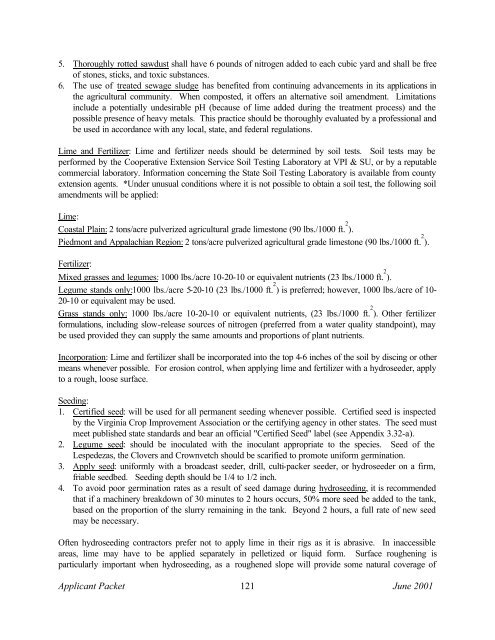APPLICANT PACKET - Virginia Department of Conservation and ...
APPLICANT PACKET - Virginia Department of Conservation and ...
APPLICANT PACKET - Virginia Department of Conservation and ...
Create successful ePaper yourself
Turn your PDF publications into a flip-book with our unique Google optimized e-Paper software.
5. Thoroughly rotted sawdust shall have 6 pounds <strong>of</strong> nitrogen added to each cubic yard <strong>and</strong> shall be free<br />
<strong>of</strong> stones, sticks, <strong>and</strong> toxic substances.<br />
6. The use <strong>of</strong> treated sewage sludge has benefited from continuing advancements in its applications in<br />
the agricultural community. When composted, it <strong>of</strong>fers an alternative soil amendment. Limitations<br />
include a potentially undesirable pH (because <strong>of</strong> lime added during the treatment process) <strong>and</strong> the<br />
possible presence <strong>of</strong> heavy metals. This practice should be thoroughly evaluated by a pr<strong>of</strong>essional <strong>and</strong><br />
be used in accordance with any local, state, <strong>and</strong> federal regulations.<br />
Lime <strong>and</strong> Fertilizer: Lime <strong>and</strong> fertilizer needs should be determined by soil tests. Soil tests may be<br />
performed by the Cooperative Extension Service Soil Testing Laboratory at VPI & SU, or by a reputable<br />
commercial laboratory. Information concerning the State Soil Testing Laboratory is available from county<br />
extension agents. *Under unusual conditions where it is not possible to obtain a soil test, the following soil<br />
amendments will be applied:<br />
Lime:<br />
Coastal Plain: 2 tons/acre pulverized agricultural grade limestone (90 lbs./1000 ft. 2<br />
).<br />
Piedmont <strong>and</strong> Appalachian Region: 2 tons/acre pulverized agricultural grade limestone (90 lbs./1000 ft. 2<br />
).<br />
Fertilizer:<br />
Mixed grasses <strong>and</strong> legumes: 1000 lbs./acre 10-20-10 or equivalent nutrients (23 lbs./1000 ft. 2<br />
).<br />
Legume st<strong>and</strong>s only:1000 lbs./acre 5-20-10 (23 lbs./1000 ft. 2<br />
) is preferred; however, 1000 lbs./acre <strong>of</strong> 10-<br />
20-10 or equivalent may be used.<br />
Grass st<strong>and</strong>s only: 1000 lbs./acre 10-20-10 or equivalent nutrients, (23 lbs./1000 ft. 2<br />
). Other fertilizer<br />
formulations, including slow-release sources <strong>of</strong> nitrogen (preferred from a water quality st<strong>and</strong>point), may<br />
be used provided they can supply the same amounts <strong>and</strong> proportions <strong>of</strong> plant nutrients.<br />
Incorporation: Lime <strong>and</strong> fertilizer shall be incorporated into the top 4-6 inches <strong>of</strong> the soil by discing or other<br />
means whenever possible. For erosion control, when applying lime <strong>and</strong> fertilizer with a hydroseeder, apply<br />
to a rough, loose surface.<br />
Seeding:<br />
1. Certified seed: will be used for all permanent seeding whenever possible. Certified seed is inspected<br />
by the <strong>Virginia</strong> Crop Improvement Association or the certifying agency in other states. The seed must<br />
meet published state st<strong>and</strong>ards <strong>and</strong> bear an <strong>of</strong>ficial "Certified Seed" label (see Appendix 3.32-a).<br />
2. Legume seed: should be inoculated with the inoculant appropriate to the species. Seed <strong>of</strong> the<br />
Lespedezas, the Clovers <strong>and</strong> Crownvetch should be scarified to promote uniform germination.<br />
3. Apply seed: uniformly with a broadcast seeder, drill, culti-packer seeder, or hydroseeder on a firm,<br />
friable seedbed. Seeding depth should be 1/4 to 1/2 inch.<br />
4. To avoid poor germination rates as a result <strong>of</strong> seed damage during hydroseeding, it is recommended<br />
that if a machinery breakdown <strong>of</strong> 30 minutes to 2 hours occurs, 50% more seed be added to the tank,<br />
based on the proportion <strong>of</strong> the slurry remaining in the tank. Beyond 2 hours, a full rate <strong>of</strong> new seed<br />
may be necessary.<br />
Often hydroseeding contractors prefer not to apply lime in their rigs as it is abrasive. In inaccessible<br />
areas, lime may have to be applied separately in pelletized or liquid form. Surface roughening is<br />
particularly important when hydroseeding, as a roughened slope will provide some natural coverage <strong>of</strong><br />
Applicant Packet 121<br />
June 2001
















